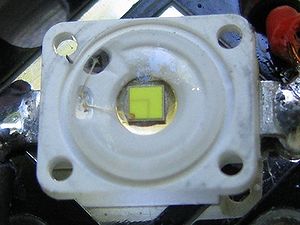Osram
Osram is a German company owned by Siemens. Their subsidiary that produces LED's is called Osram Opto Semiconductors GmbH.

Golden Dragon Plus
Osram is known for the Golden Dragon series of LED's and the OSTAR multiple-die LED's. The Golden Dragon Plus LED (comparable to a Cree XP-E) was used in several NiteCore flashlight models and is still used in some budget models (e.g. the Black Cat HM-01, Tank007 E07, and Uniquefire AA-S1). The Golden Dragon Plus is denoted by the product code W5AM while the regular Golden Dragon is W5SM. The difference between the two seems to be the Plus has a clear silicone lens over the LED while the Golden Dragon has flatter clear resin. However for some reason, the GDP seems to have a wider hotspot which is opposite of what a lens should do. There are tint families for warm white (product code LCW, also includes neutral white tints), white (LW), and ultra white (LUW, others call it cool white).
| Bin | 350mA 100% |
700mA 170% |
1000mA 220% |
|---|---|---|---|
| JZ | 61-71 | 104-121 | 134-156 |
| KX | 71-82 | 121-139 | 156-180 |
| KY | 82-97 | 139-165 | 180-213 |
| KZ | 97-112 | 165-190 | 213-246 |
| LX | 112-130 | 190-221 | 246-286 |
| LY* | 130-150 | 221-255 | 286-330 |
Oslon Square
The Oslon Square was announced in November 2011. Capable of being driven at currents up to 1.5 amps, it is a rough equivalent of the Cree XP-G, although the LED itself is a little smaller a 3mm by 3mm. The LED is binned at 700mA. The LED is binned by tints using the ANSI scheme below. The Oslon Square EC is warm white and a minimum CRI of 80, the PC runs 4000-5000K with a minimum CRI of 70, the UW is 5300-6500K and a minimum CRI of 65.
| Bin | 350mA 56.5% |
700mA 100% |
1000mA 132% |
1500mA 172% |
|---|---|---|---|---|
| LT | 85-93 | 150-164 | 198-216 | 258-279 |
| LU | 93-102 | 164-180 | 216-238 | 279-310 |
| MP | 102-110 | 180-194 | 238-256 | 310-334 |
| MQ | 110-119 | 194-210 | 256-277 | 334-361 |
| MR | 119-127 | 210-224 | 277-296 | 361-385 |
| MS | 127-136 | 224-240 | 296-317 | 385-413 |
| MT | 136-146 | 240-259 | 317-342 | 413-445 |
| MU | 146-158 | 259-280 | 342-370 | 445-482 |
| NP | 158-172 | 280-304 | 370-401 | 482-523 |
| NQ | 172-186 | 304-330 | 401-436 | 523-568 |
Tint Bins
The warm white and ultra white families ares sometimes binned using a system based on ANSI White with a number of subgrids overlaid on each ANSI White quadrangle and sometimes falling above or below the ANSI quadrangle. The grid has numbers which are vertical subdivisions (6500K is divided into layers 4, 5, 6, 7, and 8 with 4 falling below and 8 falling above ANSI 6500K) and letters which are horizontal (they follow the color temperatures; for instance, 6500K is divided into vertical bands C,D, and E while 5700K is divided into F and G, and no bands are cooler than ANSI 6500K). It doesn't seem to be their intention to bin by individual subgrid but by groups of subgrids, so a product might be binned as "5J7K" meaning it will somewhere between those subgrids. Finer binning might be available though.
| Bins | Subgrids | Temperature | ANSI Subgrids | Family |
|---|---|---|---|---|
| 4C-8E | 15 | 6500K | 5C-7E | ultra white |
| 5F-8G | 8 | 5700K | 5F-7G | ultra white |
| 4J-8K | 10 | 4500K | 5J-7K | neutral white |
| 4L-8N | 15 | 4000K | 5L-7N | neutral white |
| 4O-9Q | 18 | 3500K | 5O-8Q | warm white |
| 4R-9T | 18 | 3000K | 5R-8T | warm white |
| 4U-9X | 24 | 2700K | 5U-8X | warm white |
To make it a little more confusing, Osram has a different set of chromaticity groups that are not based on ANSI white but whose codes look very similar. These also appear in their datasheets for the Golden Dragon line. The regular white products only use this nonstandard approach.
External Links
These pages have more info about Osram LED's, including data sheets which contain performance information and binning and labeling info.